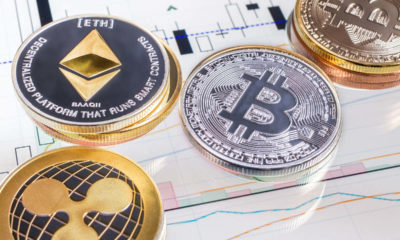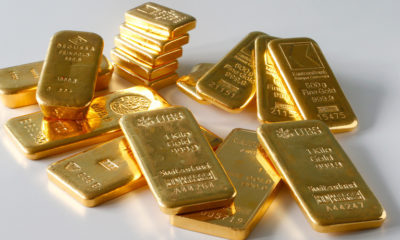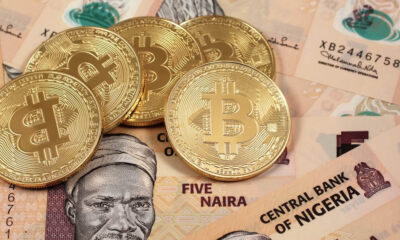Markets
Peak Inflation Nations
Published
3 years agoon

By Jeffrey Halley, Senior Market Analyst, Asia Pacific, OANDA
Equity markets ex-China are rallying today as US equity futures jump in Asian trading. Overnight, US inflation hit multi-decade highs, with YOY inflation printing at 8.50%, while core inflation rose by 6.50% YOY. But the perpetually bullish FOMO gnomes of the equity market, desperately searching for more drinks to keep the party alive, found it in the core inflation MoM data for March. Core Inflation undershot forecasts, rising 0.30% versus 0.50% expected.
That was all equity markets needed, using the singular data point to price in peak inflation in the US. Equity markets staged an impressive intraday rally and US yields eased somewhat at the long end. However, Federal Reserve President Lael Brainard, the dove who released the hawks last week, appeared on the wires still brandishing her talons vis-à-vis US monetary policy. That stopped the rally in its tracks, sending Wall Street to a slightly negative close.
Of course, it is not just the US that is grappling with inflation. India’s inflation rose back to early pandemic highs, climbing to 6.95% YoY for March, while Industrial Production flatlined, growing at just 1.70% YoY for February. The Indian Rupee only eased slightly yesterday though, and you could put that down to a strong US Dollar overnight.
This morning, my embarrassingly incompetent central bank, the Reserve Bank of New Zealand, delivered a hawkishly dovish rate hike. As predicted (even I get lucky sometimes), the RBNZ lifted its policy rate by 0.50% to 1.50%, versus market expectations of a 0.25% rise. The RBNZ noted that it was going to bring forward monetary normalisation to combat inflation. But tellingly, it left its terminal policy forecasts for 2022 and 2023 unchanged. So, it intends to check-in at the airport five hours ahead of departure, instead of 2 hours before departure. NZD/USD leapt 0.50% as the decision was announced but has since sunk all the back to down 0.10%on the day at 0.6845.
New Zealand remains my most likely country behind Russia to experience an economic hard landing this year. Sri Lanka and Pakistan have already got there. For my fellow Kiwi readers of this newsletter, I summarise the state of New Zealand thus. “The RBNZ and Government have commandeered and not consolidated the economy, I smell a RAT.”
So, what can we take away from all of the above? It appears that the market is swinging quickly to try and price “peak inflation.” The assumption is that the yield curves in places such as the United States, Britain, Europe, Australia and New Zealand have already moved higher to such an extent, that their respective central banks are now just “filling in the gaps.” Markets, after all, are forward-looking and in their wisdom have already pre-empted inflation and the central banks’ responses.
Naturally, “peak inflation” should be a reason to pile back into equities, especially as with the microbial attention span of people these days thanks to our smartphones, we are already seeing Ukraine fatigue/complacency setting in. However, it just isn’t that simple. In no particular order, the environment for equities remains challenging. President Putin said Ukraine negotiations are a dead end. Both sides are preparing for round two of the war, this time to be fought in open tank country. Russian oil production has fallen below 10 million barrels per day and OPEC is showing zero signs of moving to fill the gap. Only a return by Iran and Venezuela could do that. China’s Covid-zero policy is a looming threat to world growth. Ostensibly deflationary, severe disruption to China’s production lines and port exports will be inflationary, not deflationary. The slow-moving train wreck of China’s property sector. An impending US earnings season could highlight reduced earnings outlooks for many heavyweights.
Notably, the US Dollar kept rising overnight and US yields have not given back any meaningful recent gains. Oil prices are rising again, and Bitcoin is showing no signs of rallying. The story appears to be an equity market one, with other asset classes far more cautious. Perhaps the most cautionary note is gold, which has rallied to multi-week highs this week, despite a much stronger US Dollar and US yields. Either the gold market is walking into a bull trap – entirely plausible – or it is telling us something equity markets are ignoring.
The bottom line is that one monthly data point from the US does not a turning point make. Certainly, Chinese equities don’t think so.
On the subject of China, its March trade Balance has just been released. The headline number in US Dollar terms shot higher to $47.38 billion versus $22.4 bio expected. The headline flatters a worrying set of data, though. Exports outperformed, rising by 14.70% in March. However, imports, instead of rising by 8.0%, flat-lined to -0.10%. Slumping imports will make the noise around slowing China growth intensifies and its ramifications will shake nerves in the rest of Asia. The data shows that demand internationally for China products remains as robust as ever and mass Covid-zero shutdowns will lead to higher pricing pressures around the world. None of this trade data makes particularly good reading for anyone today.
The United Kingdom releases a swath of inflation, core inflation, RPI and PPI data today. There are upside risks to all of it and higher than expected numbers will increase the pressure on the Bank of England to accelerate tightening. That may save the Sterling from an ominous technical break of support at 1.3000 on a closing basis. The US PPI will be of passing interest if it slightly undershoots MoM. That may give more ammunition to the equity bulls. The Bank of Canada is expected to announce a 0.50% rate hike this evening as it plays catchup. Finally, given the oil rally overnight, tonight’s official US Crude Inventories should be good for volatility, especially if they retreat sharply.
Ex-China equities rally sharply in Asia.
Equity markets ex-China, in Asia, are having a positive session, helped by US index futures booking strong gains today after Lael Brainard torpedoed the “peak inflation” rally on Wall Street overnight. Overnight, The S&P 500 finished 0.34% lower, the Nasdaq lost 0.30%, and the Dow Jones fell by 0.26%. Futures in Asia have found their highs in inflation mojo once again, though. S&P 500 and Dow Jones futures have rallied by 0.50%, while Nasdaq futures have jumped by 0.75%.
That has boosted Asian markets with Japan’s Nikkei 225 leaping 1.60% higher, and South Korea’s Kospi adding 1.40%. Taipei has recorded an impressive 1.75% gain, with Singapore rising by 0.65%, Jakarta by 0.35%, and Kuala Lumpur by 0.25%. Bangkok is closed, with Manila gaining 0.25%. Australia has followed US futures higher, helped by higher overnight oil prices. The All Ordinaries has risen by 0.50%, with the ASX 200 gaining 0.35%.
China markets continue to be heavy despite government officials encouraging institutional investors to buy dips yesterday. That lead to a sharp rally by onshore equities yesterday. Today, Covid-zero nerves have returned as cases in Shanghai stay stubbornly high. As I alluded to yesterday, the small print of the easing of Shanghai restrictions contained plenty of poison pills. Flat-lining imports in today’s trade data will not alleviate concerns over domestic consumption. The Shanghai Composite has fallen 0.45%, with the CSI 300 down 0.50%. Hong Kong has limped to a 0.30% gain this morning.
President Putin’s comments about a dead-end in Ukraine negotiations and hints that he is comfortable with a drawn-out “special operation” will not sit well with European markets today. Nor will the overnight rebound in energy prices. Concerns of more hawkish guidance from tomorrow’s ECB policy meeting will also temper sentiment today.
US Dollar rally accelerates overnight.
In contrast with the exuberance of equity markets, the US Dollar rally accelerated overnight, with dollar index gains led by weakness in the Euro and Sterling. The dollar index ignored the softer monthly core-inflation print, rallying an impressive 0.34% to 100.33, where it remains in Asia. A test of 100.50 and then 101.00 seems imminent and the dollar index remains in a technical uptrend as long as support at 99.35 holds.
EUR/USD slumped 0.50% to 1.0827 overnight, as negative comments around Ukraine by President Putin, and an impending ECB policy meeting tomorrow, weighed on the single currency. EUR/USD remains uncomfortably near to the multi-year support line at 1.0800. Failure signals more losses to 1.0600 and 1.0300 initially, and possibly back to parity. Resistance is at 1.0950 and 1.1200, with longer-term resistance at 1.1300. Rising oil prices, Ukraine risks and/or an ECB moving to a hawkish stance all threaten more downside pressure.
Sterling tested support at 1.3000 once again overnight but this time, only managed to close on support at 1,3000. Positive UK data may give Sterling a temporary respite, but a daily close under 1.3000 signals another round of losses targeting 1.2850 and 1.2700.
With US yields edging lower overnight, USD/JPY remained steady at 125.40 before resuming its climb in Asia today, rising to 125.65. USD/JPY is just below its multi-year highs at 125.80 and despite some more official noise from Tokyo today, looks poised to break through it this week. That will set the scene for a test of the May 2002 highs at 128.90. Any drop to 124.00 and 123.50 should find plenty of keen dip buyers. Only a sharp fall in US yields changes the bullish outlook.
Asian currencies held steady overnight, and have rallied with equity markets this morning, continuing a pattern of choppy short-term range trading. A gentle move lower by US yields overnight proved slightly supportive. USD/KRW, USD/PHP, USD/INR, and USD/TWD are down around 0.20% today. Weak China imports will temper any gains with onshore USD/CNY, and offshore USD/CNH holding steady at 6.3660 and 6.3750. Interestingly, both USD/CNY and USD/CNH are approaching one-year trendline resistance levels, today at 6.3775 and 6.3960 respectively. Daily closes above would signal another leg of Yuan weakness.
Oil prices rally overnight.
Oil prices rallied sharply overnight as OPEC rebuffed increasing production above already agreed amounts, and Russian oil production fell below 10 mio barrels per day. Putin’s Ukraine negotiation dead-end comments also dampened hopes that a negotiated settlement could relieve tight energy markets.
Brent crude rallied 5.55% higher to $104.85, and WTI leapt 6.105 higher to 101.00 a barrel. In Asia, oil prices are almost unchanged after China imports slumped today. Asian buyers, having been able to pick and choose dips to buy into over the past week, seem reluctant to chase prices at these levels. That implies plenty of interest will be around to buy on any dips.
With the latest scheduled OPEC+ increase, and US and IEA SPR release out there and priced in, it seems that China continues to drive the bearish price action. That impact may be waning now as OPEC refuses to increase production, and the situation in Eastern Europe continues to darken. Brent and WTI have fallen to the bottom of my ranges, but I expect Brent to remain in a choppy $100.00 to $120.00 range, with WTI in a $95.00 to $115.00 range. Brent crude has further support at $96.00, and WTI at $93.00 a barrel.
Gold charges higher overnight.
Despite a much stronger US Dollar, and US yields holding steady, gold prices charged higher once again overnight. Gold rose 0.63% to $1866.50 an ounce, gaining another 0.26% to $1971.60 in Asia today.
I will admit to scratching my head about the longevity of the gold rally at this stage. Either the gold bugs are walking into a huge bull trap that will end in tears, or the gold market is telling us the inflation and geopolitical risks are much higher than we are seeing in the headlines. I know which side my money is on, but one must respect the upward momentum until it turns.
Gold has initial resistance at $1980.00, the overnight high. After that, a test of $2000.00 is entirely possible, although I believe option-related selling there will be a strong initial barrier. If that is cleared, gold could gap higher to $2020.00 an ounce quite quickly. A retreat through $1940.00 will signal a whipsaw move lower, chopping out the short-term money. Failure of $1915.00 will signal a retest of important support at $1880.00 and possibly $1800.00 an ounce. I can honestly say I don’t know which scenario will be the winner at this moment.
You may like
-


Bitcoin Soars to Record High Above $106K, Then declines as Fed Rate Cut Looms.
-


Bitcoin Hits $103K as MARA Invests $1.1 Billion in Record BTC Purchase
-


Crude Oil Prices Rise as Iran, Russia Sanctions Ease Supply Concerns
-


International Tensions Push Gold to $2,700 Per Ounce
-


Gold (XAUUSD) Stabilizes Below $2700: An Analysis of Hesitation Ahead of Inflation Data
-


Bitcoin to Replace Gold as the ‘Premier Store of Value’ Asset in The Next Decade
Sign up for our Daily newsletter
We’ll be in your inbox every morning Monday-Saturday with all the day’s top business news, inspiring stories, best advice and reporting from Entrepreneur, To share your newsletter use this email: entrepreneuredition@




